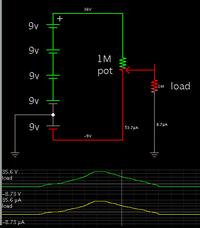awa123
Newbie level 4

- Joined
- Mar 4, 2013
- Messages
- 5
- Helped
- 0
- Reputation
- 0
- Reaction score
- 0
- Trophy points
- 1,281
- Activity points
- 1,320
Hi,
I am trying to create a power supply that outputs 0-35V using 9V batteries.
I need to be able to vary the voltage while keeping the current as low as possible.
I was thinking a potential divider would work, but I am not sure. Please help, thanks.
I am trying to create a power supply that outputs 0-35V using 9V batteries.
I need to be able to vary the voltage while keeping the current as low as possible.
I was thinking a potential divider would work, but I am not sure. Please help, thanks.





